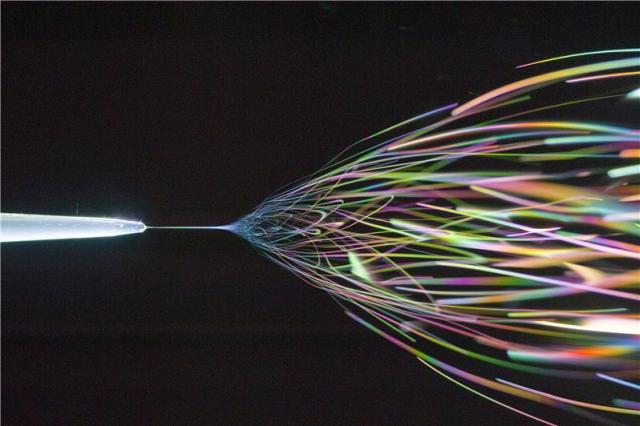Jun 17 2015
New research outlines how the creation of ‘nanofibres’ could provide new and improved products and delivery systems for supplementary foodstuffs.
 Electrospinning. Credit Robert Lamberts The New Zealand Institute for Plant & Food Research Limited
Electrospinning. Credit Robert Lamberts The New Zealand Institute for Plant & Food Research Limited
Nanofibre materials produced through a process called electrospinning are attracting particular attention in the food industry because of their potential to control the release of chemical constituents in the body.
Electrospinning uses an electrical charge to draw very fine (typically on the micro or nano scale) fibres from a liquid containing long-chain molecules – essentially providing a coating for health-promoting ingredients such as pro-biotics and vitamins. Electrospinning, and the related process of electrospraying, show promise as novel delivery vehicles for supplementary food compounds such as probiotics because they can be carried out at room temperature, with aqueous solutions and without complex coagulation chemistry. This means active ingredients can be better protected during the production process and as they pass through the digestive system.
In the journal Food Hydrocolloids, academics from the University of Lincoln, UK, and Research Institute of Food Science & Technology in Iran present a comprehensive review of the fundamentals of electrospinning to produce nanofibres suitable for food technology application.
Co-author Dr Nick Tucker from the School of Engineering, University of Lincoln, has worked on nanofibre production and sustainable packaging materials for a number of years, having previously worked with the New Zealand seafood industry and Auckland Medical School to make skin scaffolds.
Dr Tucker said: “In this paper we aim to advance the design and performance of novel products and delivery systems for supplementary food compounds.
“Different methods have been suggested, examined and applied to encapsulate and dry probiotics and bioactive compounds to protect or even enhance their survival while passing through the upper gastro-intestinal tract. However, the harsh processing conditions of methods such as spray-drying can significantly reduce the viability of bacteria or damage the structure of the target molecules.
“Electrospun nanofibres can be used as the delivery system in foods for nutrients to protect them during the processing and storage or in delivery systems for transferring the components to the target site in the body. But to optimise production conditions and maximise quantity of nanofibres, a clear understanding of the mechanism of electrospinning is essential.”
Dr Tucker, who is looking to form industrial relationships to create electrospun composites for a number of applications, believes that greater collaboration between academia and industry will stimulate future developments.
He explains: “A critical assessment of the weakness and strength points of electrospinning technologies for industrial processes would certainly be useful. Moreover, the electrospun fibres will need parallel development of both their physical form, and methods of incorporation into food stuffs. This will take a considerable development effort if the advantages of these materials are to be incorporated in the functional foods of the near future.”